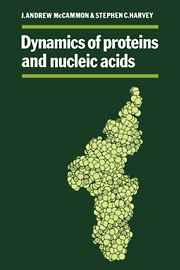Book contents
- Frontmatter
- Contents
- Preface
- 1 Introduction
- 2 Structure of proteins, nucleic acids, and their solvent surroundings
- 3 Dynamics of proteins, nucleic acids, and their solvent surroundings
- 4 Theoretical methods
- 5 Short time dynamics
- 6 Local structural transitions
- 7 Global structural changes
- 8 Dynamics of molecular associations
- 9 Recent developments and future directions
- Appendix 1 Numerical integration of the equations of motion
- Appendix 2 Detailed description of computer programs and procedures for energy minimization and molecular dynamics
- Appendix 3 Molecular dynamics at constant temperature and pressure
- References
- Index
5 - Short time dynamics
Published online by Cambridge University Press: 05 June 2012
- Frontmatter
- Contents
- Preface
- 1 Introduction
- 2 Structure of proteins, nucleic acids, and their solvent surroundings
- 3 Dynamics of proteins, nucleic acids, and their solvent surroundings
- 4 Theoretical methods
- 5 Short time dynamics
- 6 Local structural transitions
- 7 Global structural changes
- 8 Dynamics of molecular associations
- 9 Recent developments and future directions
- Appendix 1 Numerical integration of the equations of motion
- Appendix 2 Detailed description of computer programs and procedures for energy minimization and molecular dynamics
- Appendix 3 Molecular dynamics at constant temperature and pressure
- References
- Index
Summary
Introduction
In this chapter, we consider the types of motion that occur in proteins and nucleic acids during time intervals of less than 100 ps. Motions on these time scales are relatively well characterized theoretically because they can be simulated by conventional molecular dynamics techniques. Although most biological activity occurs over much longer periods of time, the types of motion described here are of interest for a variety of reasons. As indicated in chapter 3, fast motions represent a kind of dynamic background that partly determines the nature of all slower motions. For example, the frictional effects that arise from atomic collisions are essentially fully developed within a few picoseconds. Also, many structural transitions that seem to be characterized by long times are in fact fast motions that happen to occur infrequently. It was noted in section 4.9 that activated processes often involve such intrinsically fast transitions. Certain transitions that are triggered by photon absorption or electron transfer may also be intrinsically fast. The mechanistic details of such transitions can be expected to have features similar to those seen in typical fast motions. Of practical interest is that proteins and nucleic acids may explore a fairly representative sample of the conformations in the regions of their native states in time intervals of between 10 and 100 ps. As will be discussed in chapter 9, this means that useful thermodynamic quantities, such as relative free energies of ligand binding, can be obtained from simulations on these time scales.
- Type
- Chapter
- Information
- Dynamics of Proteins and Nucleic Acids , pp. 79 - 116Publisher: Cambridge University PressPrint publication year: 1987
- 4
- Cited by

